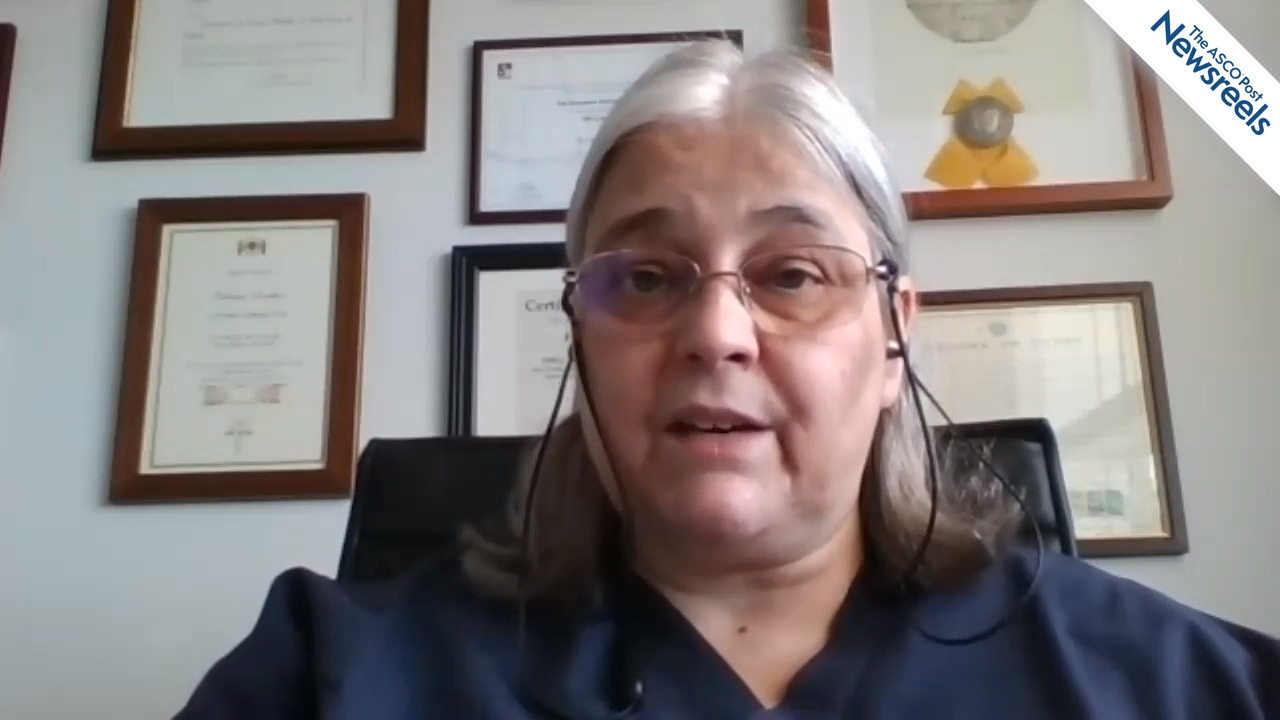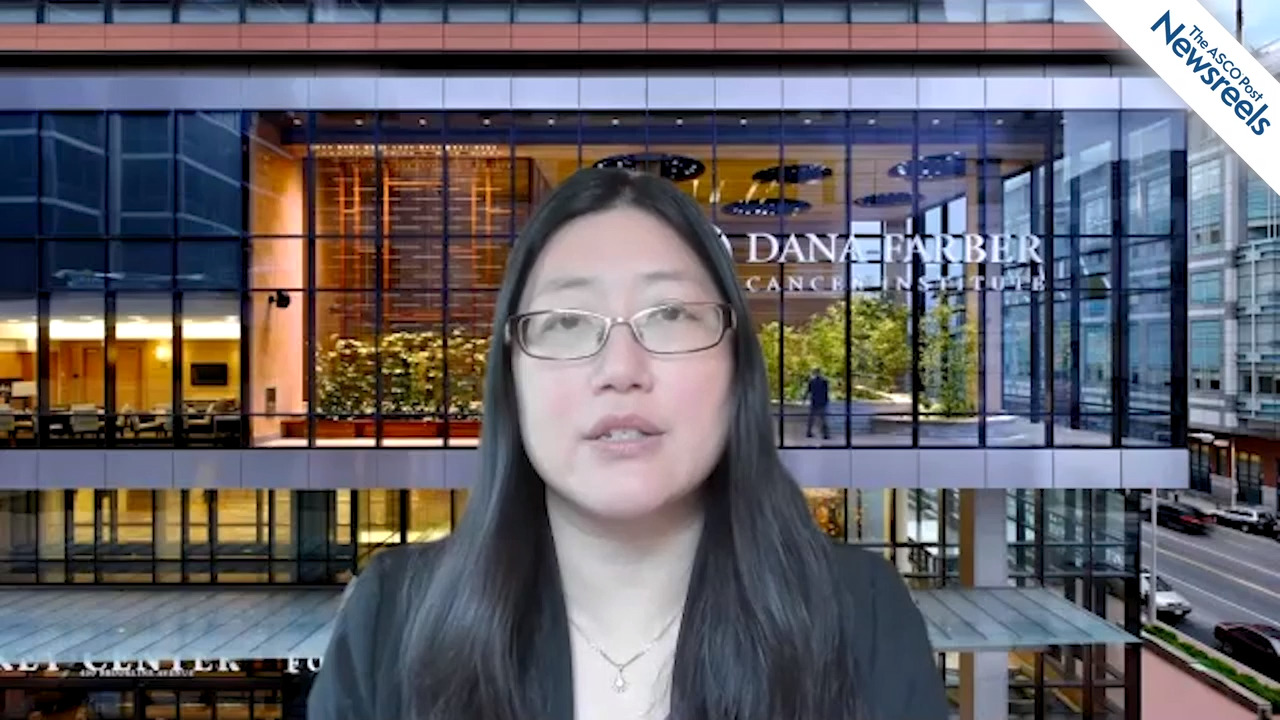Fatima Cardoso, MD, on Breast Cancer: MammaPrint as Guidance for Adjuvant Chemotherapy
Fatima Cardoso, MD, of Lisbon’s Champalimaud Cancer Center, discusses the long-term results of MINDACT, a large prospective trial showing the clinical utility of the 70-gene signature MammaPrint for adjuvant chemotherapy decision-making. The primary distant metastasis–free survival endpoint at 5 years continued to be met in chemotherapy-untreated women with clinical-high/genomic-low risk disease (Abstract 506).
Nancy U. Lin, MD, on Metastatic Breast Cancer: Tucatinib, Trastuzumab, and Capecitabine
Nancy U. Lin, MD, of Dana-Farber Cancer Institute, discusses the HER2CLIMB study of patients with previously treated HER2-positive metastatic breast cancer that had metastasized to the brain. Adding tucatinib to trastuzumab and capecitabine doubled the intracranial response rate and reduced the risk of death by nearly half, compared with trastuzumab plus capecitabine (Abstract 1005).
Tucatinib Combination in Previously Treated HER2-Positive Metastatic Breast Cancer With Brain Metastases
In an analysis of the pivotal phase III HER2CLIMB trial to be reported at the ASCO20 Virtual Scientific Program, Nancy U. Lin, MD, and colleagues found that tucatinib, a small-molecule tyrosine kinase inhibitor that is highly selective for HER2, plus trastuzumab/capecitabine significantly improved...
ESMO Breast 2020: Novel Biomarkers May Predict Immunotherapy Benefit in Metastatic Breast Cancer
Two novel biomarkers have been found to correlate with improved outcomes with immunotherapy in metastatic breast cancer and may help to identify the patients most likely to benefit from this treatment, according to exploratory studies reported at the European Society for Medical Oncology (ESMO)...
ESMO Breast 2020: Study Finds Physical Activity, Supportive Care to Relieve Cancer-Related Fatigue May Be Underutilized by Breast Cancer Survivors
Cancer-related fatigue is a prevalent and potentially persistent issue among breast cancer survivors. A study presented by Di Meglio et al at the ESMO Breast Cancer Virtual Meeting 2020 (Abstract 183O) has now shown that existing recommendations and proven strategies for reducing fatigue—which can...
ESMO Breast 2020: Ipatasertib/Paclitaxel vs Paclitaxel Alone in Advanced Triple-Negative Breast Cancer
Final analysis of the LOTUS trial has shown numerically longer overall survival with ipatasertib plus paclitaxel vs placebo plus paclitaxel in patients with inoperable locally advanced/metastatic triple-negative breast cancer. In all biomarker-defined subgroups (PTEN normal or low, PIK3CA/AKT1/PTEN ...
ESMO Breast 2020: Patient Preference for Subcutaneous vs Intravenous Pertuzumab/Trastuzumab for HER2-Positive Early Breast Cancer
At the European Society for Medical Oncology (ESMO) Breast Cancer Virtual Meeting 2020, Joyce O’Shaughnessy, MD, of Baylor University Medical Center, reported results from an interim analysis of the PHranceSCa study (Abstract 80O). The study investigators found that over 80% of patients preferred...
ASBrS 2020: Analysis of Women Younger Than 40 With Breast Cancer
Patients with breast cancer younger than 40 generally present with a characteristic profile—later-stage disease and more aggressive tumors with poorer prognosis—according to findings from a new study analyzing one of the largest patient data sets compiled to investigate age-related breast cancer...
ASBrS 2020: Phone Outreach and Scheduling Assistance Boost Mammography Uptake at an Urban Safety-Net Hospital
Telephone outreach coupled with scheduling assistance significantly increased screening mammography setup and follow-through in a population characterized by low rates of screening mammography and high rates of advanced breast cancer at diagnosis. These are findings from a new study conducted by...
ASBrS 2020: Cosmetic Outcomes With Lumpectomy for Multiple Ipsilateral Breast Cancer
The majority of women with multiple tumors in a single breast reported good or excellent satisfaction with the cosmetic results of lumpectomy, despite loss of significant breast volume and often multiple incisions. These findings are from an ongoing multicenter prospective trial examining the...
Tucatinib in Previously Treated HER2-Positive Metastatic Breast Cancer
On April 17, 2020, tucatinib was approved for use in combination with trastuzumab and capecitabine for treatment of adult patients with advanced unresectable or metastatic HER2-positive breast cancer. These patients included those with brain metastases and those who have received one or more prior...
Genetics May Soon Guide Targeted Treatment of Brain Metastases
Genetic mapping of brain metastases, in the laboratory of Priscilla Brastianos, MD, Director of the Central Nervous System Metastasis Center at Massachusetts General Hospital/Harvard Medical School, and Scott Carter, PhD, at the Harvard School of Public Health, is yielding findings that could...
Expert Point of View: Pamela N. Munster, MD
Formal I-SPY 2 trial discussant, Pamela N. Munster, MD, Professor in the Department of Medicine, University of California, San Francisco, found the study promising but said confirmatory trials are needed. “What we know so far in preoperative therapy for breast cancer is that pathologic complete...
Selected Poster Presentations on Cancer Therapeutics and More
Although the live 2020 National Comprehensive Cancer Network (NCCN) Annual Conference was canceled, more than 100 posters scheduled for presentation are now available online, as part of the NCCN 2020 Virtual Annual Conference. The ASCO Post has summarized some of the clinical trial updates we found ...
Does Text Messaging Support Adherence to Adjuvant Aromatase Inhibitor Therapy in Women With Early-Stage Breast Cancer?
In the SWOG S1105 trial reported in the Journal of Clinical Oncology, Dawn L. Hershman, MD, MS, and colleagues found that a text message intervention did not reduce the rate of early discontinuation of adjuvant aromatase inhibitor therapy in postmenopausal women with early-stage breast cancer....
Jennifer K. Litton, MD, on Breast Cancer: EMBRACA Trial on Talazoparib vs Chemotherapy
Jennifer K. Litton, MD, of The University of Texas MD Anderson Cancer Center, discusses study results of talazoparib vs chemotherapy in patients with BRCA1/2-mutated HER2-negative advanced breast cancer. In this final analysis, patient-reported outcomes continued to favor the PARP inhibitor, even though it did not improve overall survival compared with chemotherapy (Abstract CT071).
Pooled Analysis Supports Benefit of Dual HER2-Targeted Therapy, but Questions Remain
In the treatment of HER2-positive early breast cancer, patients who receive dual HER2-targeted therapy in both the neoadjuvant and adjuvant settings are less likely to experience recurrence than those who received dual therapy only as neoadjuvant treatment, according to a pooled analysis of...
KEYNOTE-522: A Biomarker Resource for PD-1 Inhibition in Early Triple-Negative Breast Cancer
In the phase III KEYNOTE-522 trial reported in The New England Journal of Medicine and reviewed in this issue of The ASCO Post, Schmid et al1 found that the addition of pembrolizumab to neoadjuvant chemotherapy in stage II or III triple-negative breast cancer significantly improved the pathologic...
Neoadjuvant and Adjuvant Pembrolizumab Improves Outcomes in Early Triple-Negative Breast Cancer
As reported in The New England Journal of Medicine by Peter Schmid, MD, PhD, of Barts Cancer Institute, Queen Mary University of London, and colleagues, analyses in the phase III KEYNOTE-522 trial have shown that the addition of pembrolizumab to neoadjuvant chemotherapy and the use of adjuvant...
Expert Point of View: Virginia Kaklamani, MD, DSc, and Minetta Liu, MD
Virginia Kaklamani, MD, DSc, Professor of Medicine and Head of the Breast Cancer Program at UT Health San Antonio MD Anderson Cancer Center, moderated a press conference where Milan Radovich, PhD, reported the robust ability of circulating tumor DNA (ctDNA) and circulating tumor cells to predict...
Studies Show Circulating Tumor Material May Predict Outcomes After Neoadjuvant Therapy for Breast Cancer
In early triple-negative breast cancer, the presence of circulating tumor DNA (ctDNA) and circulating tumor cells after neoadjuvant chemotherapy may enable risk stratification of patients for disease recurrence and may predict outcomes, according to a preplanned correlative analysis of the phase II ...
Joint Guideline Sheds Light on Management of Hereditary Breast Cancer
As germline genetic testing becomes more widespread among patients with breast cancer, recommendations for the appropriate management of patients with hereditary breast cancer are needed. Until now, no ASCO guideline has addressed the management of hereditary breast cancer, even for carriers of...
Vascular Imaging for Detection of Breast Cancer: Best of Two Worlds?
For breast imaging, contrast-enhanced mammography, which uses the anatomic imaging of a mammogram in addition to imaging neovascularity, can offer the overall screening capability of standard mammography and the sensitivity of magnetic resonance imaging (MRI) at a fraction of the cost of MRI,...
Can Breast Cancer Surgery Be Eliminated in ‘Exceptional Responders’ to Neoadjuvant Therapy?
Can patients with breast cancer who achieve an “exceptional response” to neoadjuvant therapy safely forgo surgery? That is a question being seriously explored in multinational trials. “We’ve known for a long time that we can eliminate disease in many patients if they have chemosensitive tumors....
Steven J. O’Day, MD, on Triple-Negative Breast Cancer: Clinical Benefit With Pembrolizumab Plus Imprime PGG
Steven J. O’Day, MD, of the John Wayne Cancer Institute, discusses phase II results for the combination of pembrolizumab with a novel innate immune activator, Imprime PGG, as second-line treatment for patients with metastatic triple-negative breast cancer ( Abstract CT073).
FAST-Forward Trial: Long-Term Outcomes With Adjuvant Hypofractionated Radiotherapy for 1 vs 3 Weeks in Early Breast Cancer
As reported in The Lancet by Brunt et al, 5-year findings from the phase III FAST-Forward trial indicated that adjuvant radiotherapy with 26 Gy in 5 fractions over 1 week was noninferior to 40 Gy in 15 fractions over 3 weeks in preventing local tumor relapse in women with early-stage breast ...
Abemaciclib/Fulvestrant/Trastuzumab for Patients With Previously Treated HR-Positive, HER2-Positive Advanced Breast Cancer
In the phase II monarcHER trial reported in The Lancet Oncology, Sara M. Tolaney, MD, and colleagues found that the combination of abemaciclib, fulvestrant, and trastuzumab prolonged progression-free survival vs trastuzumab plus standard-of-care chemotherapy in patients with previously treated...
Lajos Pusztai, MD, PhD, on Breast Cancer: I-SPY2 Trial on Durvalumab, Olaparib, and Paclitaxel
Lajos Pusztai, MD, PhD, of Yale Cancer Center, discusses study results on durvalumab in combination with olaparib and paclitaxel as neoadjuvant treatment in patients with high-risk HER2-negative stage II/III breast cancer. Compared with patients who received chemotherapy alone, the combination improved pathologic complete response, even in women with triple-negative breast cancer (Abstract CT011).
Avoiding Use of Prophylactic Peg-filgrastim During Paclitaxel Treatment in Dose-Dense Chemotherapy for Breast Cancer
In a phase II study reported in the Journal of Clinical Oncology, Vaz-Luis et al found that the use of a prespecified algorithm enabled the avoidance of routine peg-filgrastim prophylaxis during the paclitaxel portion of neoadjuvant or adjuvant treatment with dose-dense...
AACR 2020: I-SPY2 Trial: Durvalumab/Olaparib/Paclitaxel ‘Graduates’ in HER2-Negative Breast Cancer
The I-SPY2 trial found that the combination of the checkpoint inhibitor durvalumab, the PARP inhibitor olaparib, and the taxane paclitaxel followed by doxorubicin/cyclophosphamide as neoadjuvant therapy improved pathologic complete responses vs paclitaxel followed by doxorubicin/cyclophosphamide...
AACR 2020: Final Overall Survival Results From the Phase III EMBRACA Trial
New data from the phase III EMBRACA trial showed the poly (ADP-ribose) polymerase (PARP) inhibitor talazoparib did not produce a statistically significant overall survival benefit for patients with locally advanced or metastatic HER2-negative germline BRCA-mutated breast cancer. Most patients...
21-Gene Assay Recurrence Score and Risk of Locoregional Recurrence in Hormone Receptor–Positive, Node-Positive Breast Cancer
A retrospective analysis from the Southwest Oncology Group S8814 trial, reported by Wendy A. Woodward, MD, PhD, of the Department of Radiation Oncology, The University of Texas MD Anderson Cancer Center, and colleagues in JAMA Oncology,1 showed that a low 21-gene assay recurrence score was...
ASCENT Study Halted: Efficacy Shown Across Multiple Study Endpoints in Triple-Negative Breast Cancer
The phase III confirmatory ASCENT study of the antibody drug-conjugate sacituzumab govitecan will be stopped based on efficacy across multiple study endpoints following unanimous recommendation from the independent data safety monitoring committee, according to a news release issued earlier this...
Beyond CDK4/6 Inhibitors: What Subsequent Treatment Is Best?
Inhibitors of cyclin-dependent kinases 4 and 6 (CDK4/6) have changed the natural history of hormone receptor–positive metastatic breast cancer. While median progression-free survival on these drugs is approximately 27 months, the disease eventually progresses and clinicians must choose a subsequent ...
More Antibody-Drug Conjugates on the Horizon for Breast Cancer
Novel antibody-drug conjugates that target actionable cell-surface markers in metastatic breast cancer will soon expand the utility of the class that already includes ado-trastuzumab emtansine (T-DM1), according to two speakers at the 2020 Miami Breast Cancer Conference. These new agents were...
What’s the Current Status of Neoadjuvant Immunotherapy?
For several tumor types, can the successes achieved with immunotherapy in the metastatic and adjuvant settings be replicated in the neoadjuvant setting? An explosion in clinical trials—with more than 300 listed on ClinicalTrials.gov—point to “yes.” “The neoadjuvant use of immunotherapy is of great ...
Effect of Payer’s Utilization Management Policy on Uptake of Hypofractionated Radiotherapy Among Eligible Patients With Early-Stage Breast Cancer
In a study reported in JAMA Oncology, Ravi B. Parikh, MD, MPP, and colleagues found that a large commercial payer’s utilization management policy was associated with increased use of hypofractionated radiotherapy among eligible women with early-stage breast cancer. The investigators noted,...
FDA Approves Sacituzumab Govitecan-hziy for Patients With Previously Treated Metastatic Triple-Negative Breast Cancer
On April 22, the U.S. Food and Drug Administration (FDA) approved sacituzumab govitecan-hziy (Trodelvy) for the treatment of adult patients with metastatic triple-negative breast cancer who have received at least two prior therapies for metastatic disease. Sacituzumab govitecan-hziy is the first...
Cognitive Impairment With Adjuvant Chemoendocrine vs Endocrine Therapy for Early Breast Cancer in the TAILORx Trial
In a study reported in the Journal of Clinical Oncology, Wagner et al found that patient-reported cognitive impairment was worse at 3 and 6 months in women with early breast cancer receiving adjuvant chemoendocrine therapy vs endocrine therapy alone in the TAILORx trial, with no significant...
Sara A. Hurvitz, MD, on Talazoparib vs Chemotherapy for Breast Cancer: Results From the EMBRACA Trial
Sara A. Hurvitz, MD, of the University of California, Los Angeles, discusses racial differences in self-reported outcomes of patients with HER2-negative, locally advanced or metastatic breast cancer and a germline BRCA1/2 mutation who received talazoparib vs physician’s choice of chemotherapy (Abstract CLO20-039).
Addition of Capecitabine to Taxane/Anthracycline Adjuvant Chemotherapy for Triple-Negative Breast Cancer
In a Chinese phase III trial reported in the Journal of Clinical Oncology, Li et al found that the addition of capecitabine to taxane/anthracycline adjuvant therapy for triple-negative breast cancer was associated with improved disease-free survival. Study Details In the open-label multicenter...
Quantitative Microelastography for Tumor Detection in Breast-Conserving Surgical Margins
A high-resolution, three-dimensional imaging technique, when combined with quantitative measurement of tissue elasticity, could accurately detect cancer within the resected margins of surgical specimens taken from patients undergoing breast-conserving surgery, according to a study published by...
FDA Approves Tucatinib in Combination With Trastuzumab/Capecitabine for Advanced Unresectable or Metastatic HER2-Positive Breast Cancer
On April 17, the U.S. Food and Drug Administration (FDA) granted approval to tucatinib (Tukysa) in combination with trastuzumab/capecitabine for adult patients with advanced unresectable or metastatic HER2-positive breast cancer, including patients with brain metastases, who have received one or...
Multidisciplinary Recommendations for Breast Cancer Care During the COVID-19 Pandemic
The American Society of Breast Surgeons (ASBrS), the National Accreditation Program for Breast Centers (NAPBC), the National Comprehensive Cancer Network® (NCCN®), the Commission on Cancer (CoC) of the American College of Surgeons, and the American College of Radiology (ACR) have released new joint ...
Delayed Targeted Intraoperative Radiotherapy vs Whole-Breast Radiotherapy in Early Breast Cancer
As reported in JAMA Oncology by Jayant S. Vaidya, MBBS, PhD, and colleagues, the phase III TARGIT-A trial showed that delayed second-procedure targeted intraoperative radiotherapy (TARGIT-IORT) was not noninferior to whole-breast external-beam radiotherapy (EBRT) in preventing local recurrence of...
William J. Gradishar, MD, on Innovating Pathways for Patient Self-Management in Breast Cancer
William J. Gradishar, MD, of Robert H. Lurie Comprehensive Cancer Center of Northwestern University, discusses the “4R Model” (Right Information, Care, Patient, and Time) which has proved to be a promising method for patient self-management. Patient care sequence plans markedly improved several aspects of patient self-management, as well as delivery of multimodality care (Abstract BPI20-017).
Elizabeth Reed, MD, on Helping Providers in Rural Areas Meet the Needs of Younger Patients With Breast Cancer
Elizabeth Reed, MD, of the University of Nebraska Medical Center Fred & Pamela Buffett Cancer Center, talks about how she and her team sought to help rural oncology providers recognize and address the physical, psychosocial, and decision-making needs of young women with breast cancer by implementing clinical pathways and treatment guidelines (Abstract BPI20-014).
Updates From Selected Clinical Trials in Breast Cancer
Each year, The ASCO Post asks Jame Abraham, MD, FACP, Chairman of the Department of Hematology and Medical Oncology at Taussig Cancer Institute and Professor of Medicine at the Cleveland Clinic Lerner College of Medicine, to offer his picks for the most important research presented at 2019 San...
Inspired by Her Physician Father, Reshma Jagsi, MD, DPhil, Tirelessly Advocates for Women’s Health and Careers in Medicine
Physician-scientist, Reshma Jagsi, MD, DPhil, was encouraged by her parents to become a politically active, socially conscious citizen of the world. “As a young woman, my mother traveled from Africa on a scholarship to the United States, where she attended the University of Wisconsin. It was in the ...
Should Restrictions on Genetic Testing Be Loosened?
The loosening of restrictions on genetic testing would mean that all health-care providers could help move this needle to where it should be, according to Kevin S. Hughes, MD, a surgeon at Massachusetts General Hospital, Professor of Surgery at Harvard Medical School, and Medical Director of the...








